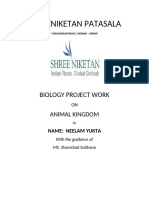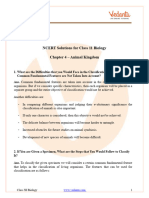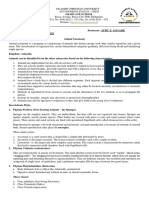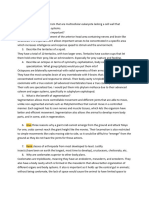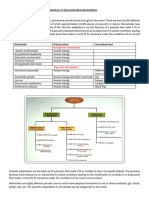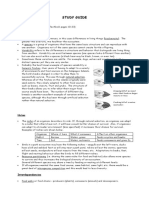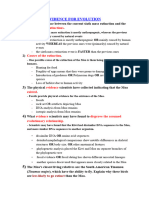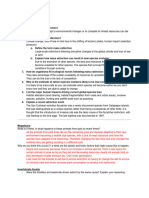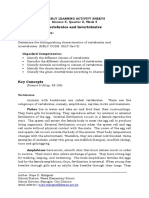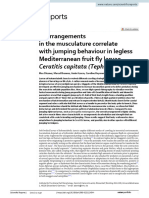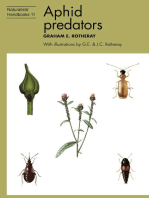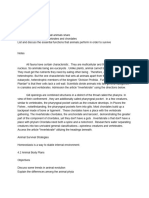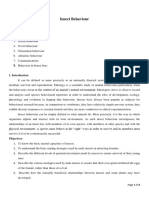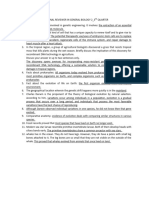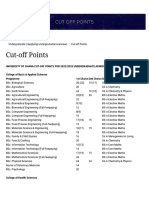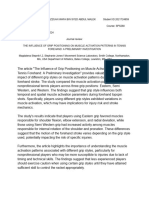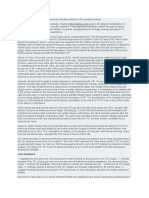ATQ (Bio Lab 12) E7
ATQ (Bio Lab 12) E7
Uploaded by
fizzypurplesodaCopyright:
Available Formats
ATQ (Bio Lab 12) E7
ATQ (Bio Lab 12) E7
Uploaded by
fizzypurplesodaOriginal Description:
Original Title
Copyright
Available Formats
Share this document
Did you find this document useful?
Is this content inappropriate?
Copyright:
Available Formats
ATQ (Bio Lab 12) E7
ATQ (Bio Lab 12) E7
Uploaded by
fizzypurplesodaCopyright:
Available Formats
Isabelle Dominique S.
Cabazor
2013-13543
September 23, 2014
Answers to Thought Questions for Exercise 7
1. Segmentation is said to have developed in chordates, arthropods, and annelids from a common
ancestor. Environmental conditions and needs of the specific animal caused the variations in the
manifestations of segmentation in these three groups. The evolutionary significance of segmentation is
that it caused the diversity of the arthropods making them one of the most successful phyla, with the
most number of species and individuals. Segments enable the organism to fulfill a specific need by
specializing a part (or a segment) of itself rather than growing a new organ for a specific purpose.
(Source: http://www.sciencedaily.com/releases/2010/07/100726222316.htm)
2. Some species of leeches did not evolve to have teeth that can pierce the skin of animals. These are
the predacious leeches usually found in temperate regions. There are relatively less of these leeches
probably because they expend more energy looking for and ambushing prey to swallow whole.
Meanwhile, the blood-sucking leeches (either proboscidate or non-proboscidate) make up most of the
population because of their food source. Blood contains much of the nutrients needed by the leech to
survive. Most leeches are able to ingest huge amounts of blood (ten times their size, for some) which
means that they can store up a lot of blood which can sustain them for a while even if they dont find a
new host. This is advantageous compared to the predacious leeches that have to consistently stalk and
ambush a new prey in order to keep going since they cannot store up their prey in their bodies in the
same way that blood-sucking leeches store up blood in their bodies.
(Source: Modern Text Book of Zoology: Invertebrates By Prof. R.L.Kotpal p 517-518)
3. The similarities between cephalopod eyes and vertebrate eyes (specifically human eyes) arise from
the fact that cephalopods are predators that rely heavily on sight to capture their prey. Cephalopods are
also capable of communication and behavioural interaction, which both involve the use of eyes. The
pupils of cephalopods are able to dilate and contract very quickly much like vertebrate eyes allowing
them to focus on tracking prey even in the depths of the ocean. They also have retinal sensitivity that is
very close to the retinal sensitivity of human eyes both in sophistication and in the fact that it improves
as the organism matures. Lastly, their lenses are sensitive and provide clear imaging which, as
mentioned before, is essential in their capture of prey.
(Source: http://www.mapoflife.org/topics/topic_7_Camera-eyes-of-cephalopods/)
4. Bio-indication involves measuring the environmental damage found in a certain place. It is done by
measuring the amount of contaminants or the amount of accumulated toxins of some chosen species to
determine the level of contamination in a given area. Shellfish (such as Perna viridis) are able to ingest
metals and other toxins due to their high tolerance. The toxins damage the reproductive organs of male
and female P. viridis making them an excellent measure of the amount of water pollution in aquatic
ecosystems.
(Source: Metallothionein gene expression in green mussels (Perna viridis) as a bioindicator for heavy
metal on the North Coast of Java and its impact on the development of reproductive organs by Yulia
Irnidayanti, Shofy Septiana and Apriliana Layli Fitri, Jakarta State University)
5. Nematodes are somehow able to evade the immunity response of gastropods causing them to
become excellent intermediate hosts for these parasites. An example of this is the parasite Schistosoma
mansoni using snails as intermediate hosts. The immunity response of the snail involves hemocytes
encapsulating the parasite and eliminating it. However, S. mansoni has found a way to survive being
eliminated by the snails immune response allowing them to use the snail to multiply. It also doesnt
help that invertebrates generally do not have an adaptive immune system to counter these mutations of
the parasites making them excellent hosts.
(Source: Cathepsin B Homologue at the Interface between a Parasitic Nematode and Its Intermediate
Host by Michael S. Duffy, Deanne K. Cevasco, Dante S. Zarlenga, Woraporn Sukhumavasi, and Judith A.
Appleton)
6. According to John R. Meyer from North Carolina State University, there is no one all-encompassing
ecological or physiological trait that could attribute to the longevity of this group of organisms. It is a
combination of various characteristics that enabled the insects to survive planet-wide extinctions and
efforts (by humans and other predators) to eliminate them. (1)Their exoskeleton gives them protection,
prevents desiccation, provides shape and support for the entire body, and allows them freedom of
movement through the joints found in the exoskeleton. (2)The small size of the insects does not require
too much nourishment to sustain and also allows them to evade predators by camouflaging or hiding
themselves in their surroundings. (3)Insects are the only invertebrates that can fly allowing them to
evade predators and is an effective mode of transport, enabling them to cover a lot of land when it
comes to looking for food. (4)They have very effective modes of reproduction that allow them to
produce a lot of eggs and to have a lot of these eggs hatch successfully. These combined with the short
life cycle of insects allow them to be very effective as a group in sustaining their population.
(5)Metamorphosis of insects allows them to have a compartmentalized life cycle. In most insects, this
means that the larval stage is devoted to feeding and growth (e.g. caterpillar) while the adult stage is
devoted to reproduction (e.g. butterfly). (6) Lastly, their ability to adapt to constantly changing
environment and resources allow them to thrive in even the most extreme environments.
(Source: http://www.cals.ncsu.edu/course/ent425/text01/success.html)
7. The hermit crab grows very slowly and chooses its shell very carefully. The main consideration for
choosing the shell is the size of its opening. The opening must not be too big or too small for the hermit
crab. It must also be big enough to protect the soft abdomen of the crab. Its shape and weight must also
allow the crab to move around.
(Sources:
http://academic.reed.edu/biology/professors/srenn/pages/teaching/web_2007/mdes_website/index.ht
ml
http://www.hermitcrabpatch.com/Hermit-Crab-Shell-Selection-a/149.htm)
8. Colonial insects, such as ants, use heavenly bodies to navigate to and from their colony despite being
blind. These skylight cues and counting their steps help them find there way back to their colony after
finding a food source to bring back. They also secrete certain hormones that mark the path they have
taken, usually directing to a food source. This path can also be detected by other ants who will help
bring the food to the colony.
(Source: http://www.esa.int/gsp/ACT/doc/EVENTS/InnovativeSystemWorkshop2/ACT-ART-
Bridge2Space-Seidl.pdf)
9. Spider webs suit the specific need of the spider that weaves them. Although not all types of prey can
be captured by just one web form or orientation, maximizing retention, interposition and stopping
abilities of the web is taken into account. Spiders that aim to capture heavier prey build webs that focus
in the stopping ability of the web in order for the web to absorb the preys momentum without
breaking. Meanwhile, spiders that aim to capture smaller and weaker prey tend to weave webs that are
better at retention so that the small insects do not escape from the web after being captured.
(Source: Annual Review of Ecology and Systematics, Vol. 21 (1990), pp. 341-372. Function and Phylogeny
of Spider Webs by William G. Eberhard)
You might also like
- SBI4U Unit 5 Practice Test AnswersDocument6 pagesSBI4U Unit 5 Practice Test AnswersAreebaNo ratings yet
- Hot Air Balloon - Baby Mobile Crochet PatternDocument14 pagesHot Air Balloon - Baby Mobile Crochet PatternElena Nitulescu100% (7)
- Sponges and PlacozoansDocument30 pagesSponges and Placozoansdayahfarday100% (1)
- Matthew Hundley Book Reflection "Culture Making" Andy CrouchDocument2 pagesMatthew Hundley Book Reflection "Culture Making" Andy CrouchMatthew HundleyNo ratings yet
- CHAPTER 6 Animalia (Invertebrate)Document17 pagesCHAPTER 6 Animalia (Invertebrate)mottong100% (1)
- Study Guide The Diversity and Relationships of LifeDocument6 pagesStudy Guide The Diversity and Relationships of LifemikeschallraNo ratings yet
- Grade 9 Science Biological Diversity Final Exam Preparation: Study GuideDocument14 pagesGrade 9 Science Biological Diversity Final Exam Preparation: Study GuideJelly BaldonadoNo ratings yet
- Study QuestionDocument24 pagesStudy QuestionEbookslatinosEbookslatinosNo ratings yet
- Domain Eukarya - Protist I: Diversity of LifeDocument5 pagesDomain Eukarya - Protist I: Diversity of LifeJemel VictorioNo ratings yet
- Insectsin Forensic InvestigationsDocument18 pagesInsectsin Forensic InvestigationsJudicaëlNo ratings yet
- NNNNMDocument96 pagesNNNNMramdeepramdeep02No ratings yet
- Biology CulexDocument7 pagesBiology CulexRian KurniawanNo ratings yet
- YUKTA BIO PROJECT WORKDocument20 pagesYUKTA BIO PROJECT WORKpraveenNo ratings yet
- 7MECEEBL S 2081.03.08 M-1Document16 pages7MECEEBL S 2081.03.08 M-1sonukewat9807549427No ratings yet
- Joseph Michael Cabaya General Biology Lesson 5: Evolution and Origin of Biodiversity: Patterns of Descent With ModificationDocument5 pagesJoseph Michael Cabaya General Biology Lesson 5: Evolution and Origin of Biodiversity: Patterns of Descent With ModificationJulimar CabayaNo ratings yet
- NCERT Solutions Class 11 Chapter 4 Animal Kingdom Questions and AnswersDocument10 pagesNCERT Solutions Class 11 Chapter 4 Animal Kingdom Questions and AnswerstripathibhavyaaNo ratings yet
- Kingdom Animalia-Inside QuestionsDocument20 pagesKingdom Animalia-Inside QuestionsRadhika Jakhwal100% (1)
- CHP 10Document24 pagesCHP 10Hadiya UmarNo ratings yet
- Reporters: JIMKEL PLACIO Professor: JUDY E. GIGARE Judy Anne V. FloresDocument3 pagesReporters: JIMKEL PLACIO Professor: JUDY E. GIGARE Judy Anne V. FloresJudy FloresNo ratings yet
- BIO CH 4 CLASS 11Document5 pagesBIO CH 4 CLASS 11riteshmeena2007No ratings yet
- The Phylum CtenophoraDocument3 pagesThe Phylum CtenophoraTI Journals PublishingNo ratings yet
- Rhopalocera (Butterfly) : FunctionsDocument18 pagesRhopalocera (Butterfly) : FunctionsChris Anthony EdulanNo ratings yet
- Week 5 SS2Document3 pagesWeek 5 SS2Denzel MusaNo ratings yet
- Bio Worksheet Written PortionDocument3 pagesBio Worksheet Written PortionIona KimNo ratings yet
- Basic Principles of TaxonomyDocument39 pagesBasic Principles of TaxonomyRaiven Rhyle Reyes0% (1)
- Animal Kingdom ClassificationDocument20 pagesAnimal Kingdom Classificationsarvesh672No ratings yet
- Laporan KatakDocument17 pagesLaporan Katakbertha tandiNo ratings yet
- Parasitic Adaptations in NematodaDocument4 pagesParasitic Adaptations in NematodaLamngan KeiNo ratings yet
- Pmw150a AssignmentDocument9 pagesPmw150a Assignmentsinoyolocharles09No ratings yet
- GR11 Biology CHP 4 AnimalkingdomDocument3 pagesGR11 Biology CHP 4 AnimalkingdomjhfaskfjlsafksaNo ratings yet
- 124 Lec Protozoan DiversityDocument9 pages124 Lec Protozoan Diversityinder604cheemaNo ratings yet
- Answer Key For Extension Worksheet: Unit 1Document17 pagesAnswer Key For Extension Worksheet: Unit 1Alex Lopez AmadoNo ratings yet
- Animalia KingdomDocument11 pagesAnimalia KingdomAnthony PattungNo ratings yet
- Study Guide: SPECIES DIVERSITY (Textbook Pages 10-23) VariabilityDocument11 pagesStudy Guide: SPECIES DIVERSITY (Textbook Pages 10-23) VariabilityMel Joy Raz SalvadorNo ratings yet
- Billock DissertationDocument162 pagesBillock DissertationThunderlord ZinogreNo ratings yet
- Evidence For EvolutionDocument5 pagesEvidence For EvolutionParidhi BhandariNo ratings yet
- AnimalphylaparagraphsDocument3 pagesAnimalphylaparagraphsapi-272770403No ratings yet
- Insect Bio SuccessDocument5 pagesInsect Bio Successjechmo27No ratings yet
- Els Lesson 2 Q2Document24 pagesEls Lesson 2 Q2Febrian LarosaNo ratings yet
- Biology Notes For HSCDocument29 pagesBiology Notes For HSCquinlanyiuNo ratings yet
- Compiled MicrobiologyDocument10 pagesCompiled MicrobiologySelwyn Miles RelletaNo ratings yet
- Classification Variation and Inheritance B1 Topic 1 COMPLETEDocument8 pagesClassification Variation and Inheritance B1 Topic 1 COMPLETEmonkeysaltaccNo ratings yet
- Questions- Various PhylaDocument6 pagesQuestions- Various PhylaMayieshaa KapilNo ratings yet
- Sponges and CnidariansDocument4 pagesSponges and CnidariansAINA KZNo ratings yet
- S6 - Q2 - Week 4Document10 pagesS6 - Q2 - Week 4RANDY ALVARONo ratings yet
- 2022 Article 11369Document11 pages2022 Article 11369PaolaNo ratings yet
- Biology Happy Holiday HomeworkDocument3 pagesBiology Happy Holiday HomeworkTimothy KurbyNo ratings yet
- Biology Exam GuideDocument16 pagesBiology Exam GuideKe-Deidra DaleyNo ratings yet
- Guide Questions For Experiment NoDocument6 pagesGuide Questions For Experiment NosannicolasjonasNo ratings yet
- Biological Success of InsectsDocument2 pagesBiological Success of InsectsCarlo QueriNo ratings yet
- +1 BIO-ZOO-EM-Chapter 1-3Document14 pages+1 BIO-ZOO-EM-Chapter 1-3Sun Tech50% (2)
- Notes For BiologyDocument13 pagesNotes For Biologyowogorga1No ratings yet
- M.SC - Zoology 2nd Sem Paper 2 by Dr. Arvind ShuklaDocument4 pagesM.SC - Zoology 2nd Sem Paper 2 by Dr. Arvind ShuklaTahib NddhNo ratings yet
- EchinodermDocument63 pagesEchinodermMarilyn Buac OgocNo ratings yet
- Script - 10 Insect Behaviour200228080802023232Document8 pagesScript - 10 Insect Behaviour200228080802023232muhammedshahzeb272No ratings yet
- Bio FrogDocument17 pagesBio FrogLyanna VillanuevaNo ratings yet
- Bio FrogDocument17 pagesBio FrogLyanna VillanuevaNo ratings yet
- Characteristics of Living Things - Science Learning HubDocument5 pagesCharacteristics of Living Things - Science Learning HubKaren ZhanNo ratings yet
- Additional Reviewer in General Biology 2 - Quarter 3Document2 pagesAdditional Reviewer in General Biology 2 - Quarter 3Elyza Chloe AlamagNo ratings yet
- Organismos ModelosDocument3 pagesOrganismos Modelosbrandy mirandaNo ratings yet
- Introduction To Algae-L 1Document57 pagesIntroduction To Algae-L 1Ricardo AngelNo ratings yet
- English Year 6 Ar2 Paper 2Document8 pagesEnglish Year 6 Ar2 Paper 2KellyLeeNo ratings yet
- Prabhupada Viraha Astaka PDFDocument8 pagesPrabhupada Viraha Astaka PDFAnton ArsenNo ratings yet
- Brey 2009 Biomed EngineeringDocument4 pagesBrey 2009 Biomed EngineeringsemselvanNo ratings yet
- SCM Unit 5Document24 pagesSCM Unit 5AMAN VERMANo ratings yet
- Ispe Baseline Guide v5 Commissioning and Qualification 2nd Ed 2019 PDF 2 PDF Free 5Document1 pageIspe Baseline Guide v5 Commissioning and Qualification 2nd Ed 2019 PDF 2 PDF Free 5asilveyraNo ratings yet
- Credit Transactions - Transcribed First LectureDocument5 pagesCredit Transactions - Transcribed First LectureClarisse Ann MirandaNo ratings yet
- Basic of Share MarketsDocument36 pagesBasic of Share Marketsbibashadhikari38No ratings yet
- Baked - Goods - in - Peru Panes 2019Document10 pagesBaked - Goods - in - Peru Panes 2019Dennis Marwin Pereyra DiazNo ratings yet
- MODULE 4 Team BuildingDocument39 pagesMODULE 4 Team BuildingCid PonienteNo ratings yet
- Far2835serv PDFDocument251 pagesFar2835serv PDFLucas BarriosNo ratings yet
- Giorgi L. Kavtaradze, Some Problems Concerning The Chronology of Late Neolithic - Early Metal Age Cultures of Caucasia.Document23 pagesGiorgi L. Kavtaradze, Some Problems Concerning The Chronology of Late Neolithic - Early Metal Age Cultures of Caucasia.Giorgi Leon KavtarażeNo ratings yet
- 1896 Philippine RevolutionDocument10 pages1896 Philippine RevolutionBaron DucusinNo ratings yet
- E205 Thin Lenses Data SheetDocument4 pagesE205 Thin Lenses Data Sheetೄྀ࿐ ;; kayceeNo ratings yet
- Cut-Off Points - University of Ghana PDFDocument3 pagesCut-Off Points - University of Ghana PDFfranciskwarteng677No ratings yet
- Syllabus EMCH 777Document9 pagesSyllabus EMCH 777Mamdud MithuNo ratings yet
- Assignment sps260 by SyedDocument2 pagesAssignment sps260 by Syedrizzuanjunior11No ratings yet
- Tata Steel CSRDocument12 pagesTata Steel CSRACH-18-08 GouthamNo ratings yet
- Case QuestionsDocument9 pagesCase QuestionsAnubhavNo ratings yet
- Sugar Cane Mini Mill PDFDocument4 pagesSugar Cane Mini Mill PDFJun Burias PadillaNo ratings yet
- Feasibility of Virtual Reality Delivered Transcending Self Therapy in Veterans Undergoing Residential Substance Use TreatmentDocument9 pagesFeasibility of Virtual Reality Delivered Transcending Self Therapy in Veterans Undergoing Residential Substance Use TreatmentHerald Scholarly Open AccessNo ratings yet
- Alaban vs. CA G.R. No. 156021, Sept. 23, 2005Document6 pagesAlaban vs. CA G.R. No. 156021, Sept. 23, 2005Marianne Shen Petilla0% (1)
- Dodge Ram 2006 SRM Includes SRT-10 & Diesel Factory Service Manual - WiringDocument520 pagesDodge Ram 2006 SRM Includes SRT-10 & Diesel Factory Service Manual - WiringLuis Ramón Argüello RealNo ratings yet
- Coaching Resource Pack Jade JoddleDocument16 pagesCoaching Resource Pack Jade JoddleSilas Cesar100% (1)
- Case 1175 Tractor Operators ManualDocument11 pagesCase 1175 Tractor Operators ManualiosalcidoNo ratings yet
- GOPIN, Marc - Between Eden and ArmageddonDocument321 pagesGOPIN, Marc - Between Eden and Armageddonking hirumaNo ratings yet
- Ecommerce User Experience Vol 1 User Behavior Key Findings and Executive Summary For The Series 4th Edition Kim Flaherty Nielsen Norman GroupDocument64 pagesEcommerce User Experience Vol 1 User Behavior Key Findings and Executive Summary For The Series 4th Edition Kim Flaherty Nielsen Norman Grouperjanmangir100% (8)
- Lesson Plan Size of The ProblemDocument2 pagesLesson Plan Size of The Problemapi-379007120No ratings yet
- BizTalk Server ESB Toolkit Architecture PosterDocument1 pageBizTalk Server ESB Toolkit Architecture PosterTom KakanowskiNo ratings yet












